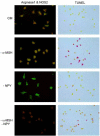Localized retinal neuropeptide regulation of macrophage and microglial cell functionality
- PMID: 20965575
- PMCID: PMC3030990
- DOI: 10.1016/j.jneuroim.2010.09.025
Localized retinal neuropeptide regulation of macrophage and microglial cell functionality
Abstract
The functionality of immune cells is manipulated within the ocular microenvironment to protect the sensitive and non-regenerating light-gathering tissue from the collateral damage of inflammation. This is mediated partly by the constitutive presence of immunomodulating neuropeptides. Treating primary resting macrophages with soluble factors produced by the posterior eye induced co-expression of Arginase1 and NOS2. The neuropeptides alpha-melanocyte stimulating hormone and Neuropeptide Y alternatively activated the macrophages to co-express Arginase1 and NOS2 like myeloid suppressor cells. Similar co-expressing cells were found within healthy, but not in wounded retinas. Therefore, the healthy retina regulates macrophage functionality to the benefit of ocular immune privilege.
Copyright © 2010 Elsevier B.V. All rights reserved.
Figures








References
-
- Alvaro AR, Rosmaninho-Salgado J, Santiago AR, Martins J, Aveleira C, Santos PF, Pereira T, Gouveia D, Carvalho AL, Grouzmann E, Ambrosio AF, Cavadas C. NPY in rat retina is present in neurons, in endothelial cells and also in microglial and Muller cells. Neurochem Int. 2007;50:757–763. - PubMed
-
- Ammar DA, Hughes BA, Thompson DA. Neuropeptide Y and the retinal pigment epithelium: receptor subtypes, signaling, and bioelectrical responses. Invest Ophthalmol Vis Sci. 1998;39:1870–1878. - PubMed
-
- Bohm M, Wolff I, Scholzen TE, Robinson SJ, Healy E, Luger TA, Schwarz T, Schwarz A. Alpha-melanocyte-stimulating hormone protects from ultraviolet radiation-induced apoptosis and DNA damage. J Biol Chem. 2004 - PubMed
-
- Bronte V, Zanovello P. Regulation of immune responses by L-arginine metabolism. Nat Rev Immunol. 2005;5:641–654. - PubMed
-
- Bruun A, Tornqvist K, Ehinger B. Neuropeptide Y (NPY) immunoreactive neurons in the retina of different species. Histochemistry. 1986;86:135–140. - PubMed
Publication types
MeSH terms
Substances
Grants and funding
LinkOut - more resources
Full Text Sources

